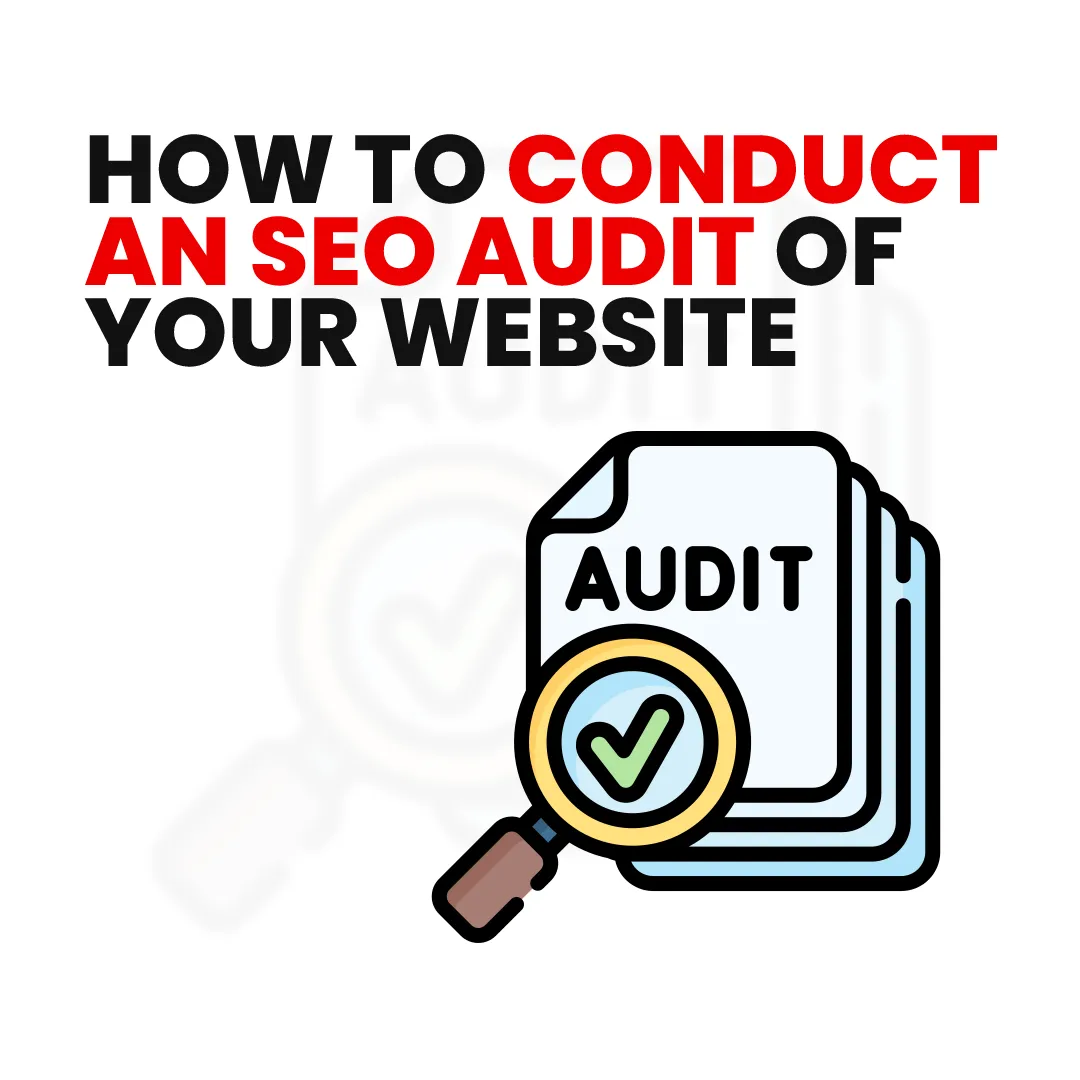Home » Search Engine Optimization »
SEO is the key in a digital era where visibility can make or break your success. Your website needs care like a garden to grow in the broad online landscape. An SEO audit can help you find hidden potential, solve errors, and boost your website’s search engine rankings.
Whether you’re an entrepreneur, blogger, or small business owner, this guide will give you the tools to undertake a complete SEO audit. Do you have the knowledge and skills to perform a thorough SEO audit? It may seem overwhelming, but a blueprint starts the journey. This article will walk you through how to complete an SEO audit. From technical analysis to on-page and off-page considerations, get ready to audit your website like a pro.

What is an SEO audit?
What is an SEO audit, and why is it important for your digital goals? Let’s deconstruct this fantastic tool that will boost your internet presence.
You created a beautiful website with captivating text and images. An SEO audit thoroughly inspects your website, assesses its health, and suggests improvements. You’ll evaluate your website’s virtual health like a doctor doing a physical exam.
Why is an SEO audit important?
Imagine having a store in Lagos—wouldn’t it be accessible, appealing, and welcoming? An SEO audit is your secret weapon for understanding how search engines see your site and optimizing it to rank higher, attract more people, and convert them into loyal customers.
An SEO audit examines many factors affecting your website’s rankings. It highlights your website’s architecture, content, technological elements, user experience, and more. These criteria help you determine what’s working, what’s not, and how to improve your search engine ranking.
As you explore your website’s convoluted alleys, you’re looking for hidden jewels to boost your rankings, traffic, and engagement. Every optimization based on your audit pushes you closer to your digital goals, from Lagos to Abuja and everywhere in between.
How to prepare for an SEO audit
Preparing for the SEO audit is the first step in optimizing your website. You’re preparing an optimization plan like a captain plotting a course before a cruise. Setting defined goals, acquiring the proper tools, and creating baseline metrics ensures focus and impact.
- Set goals and objectives: Before starting the audit, set goals. Do you want more organic traffic? Or improve keyword ranking for your website? Increase user engagement? Setting goals sets the tone for the audit and keeps you on target.
- Gather the correct tools and resources: Several free and paid tools will help you. Google Analytics for traffic analytics and Ahrefs or SEMrush for backlink analysis and keyword research.
- Establish baseline metrics: Setting baseline metrics helps you track your development. This snapshot of your starting point will let you evaluate your optimization efforts.
- Set a realistic timeline: A realistic SEO audit and implementation timetable is crucial. Consider your website size, analysis depth, and resources. A well-paced audit prevents you from missing important details.
- Prepare to get technical: A technical SEO review takes preparation. Discover technical SEO basics like robots.txt and XML sitemaps. This will make audit technicalities easier and more interesting.
- Keep an open mind: Be prepared for unexpected audit findings. The audit process typically exposes unexpected strengths and deficiencies. With curiosity and a readiness to change your strategy, investigate.
Read also: How User Experience Helps SEO in Nigeria
Technical SEO Audit
Technical audit checks your website’s technological foundation. You’ll learn how your website navigates the internet, from architecture to crawlability and mobile-friendliness to page performance.
- Evaluate website structure and architecture: A clear and organized website structure helps search engines understand your content. Are your URLs reasonable and easy to follow? Do consumers find your navigation easy? They improve user experience and help search engines index your content.
- Examine mobile-friendliness and responsiveness: Your website must be responsive in today’s mobile-dominated world. Your website should adapt to varied screen sizes. Mobile-friendliness affects search ranks due to Google’s mobile-first indexing.
- Page speed and performance test: Visitors won’t wait for a slow-loading website. Faster page load times increase user experience and search engine rankings.
- Evaluate indexing and crawlability: These tests ensure search engines can easily crawl and index your website. Check your robots.txt file to ensure it’s not obstructing critical content, then update and submit your XML sitemap to search engines.
- Finding technological Issues: Broken links and 404 errors irritate visitors and hurt SEO. Scan thoroughly to find these issues.
Website structure and architecture audit
In Nigeria’s vast digital ecosystem, your website’s structure and architecture determine search engine visibility and user experience. A well-planned city layout attracts people and visitors, while a well-organized website attracts users and search engines. Here’s how to conduct a website structure and architecture audit for SEO success.
- URLs: URLs are your website’s digital road signs. Check URLs for clarity, relevancy, and conciseness. Make sure they show users and search engines what each page is about.
- Navigation: Examine your menu structure—is it clear? Can visitors find what they need in a few clicks? Make vital pages easy to find in the main navigation.
- Internal linking: Make sure your internal links are descriptive and relevant. Links help navigate and promote SEO equity across pages.
- Clear category and subcategory structure: Assess your content classification. Categories and subcategories: logical and complete? This organization helps consumers and search engines find content.
- Evaluate content silos: Siloing aggregates related content into thematic clusters. Content silos: are they well-defined? Siloing improves user experience and helps search engines recognize content relevancy.
- Breadcrumbs: Website breadcrumbs guide users through your site’s hierarchy. Breadcrumbs assist consumers to browse and give search engines context about your content’s position.
- Pagination: Pagination simplifies long website content lists. Does your pagination split content sensibly?
- Duplicate Content: Duplicate content confuses users and hurts SEO. Find duplicate content on your website with tools.
Mobile-friendly and responsive design audit
SEO success requires mobile-friendliness in Nigeria, where mobile devices are essential to the online world. A responsive website design attracts users, and search engines like welcoming storefronts do local markets. Learn about mobile-friendliness and how to perform a responsive design audit to improve your website’s SEO.
- Accessibility starts with mobile compatibility: Check your website’s mobile usability. Do different devices and screen widths display it correctly? Visitors may easily browse your content on any device with a mobile-friendly design.
- All-screen responsive design: Responsive design adapts your website to multiple screen sizes like a tailor. Is your design responsive on smartphones, tablets, and desktops?
- Fingertip navigation: Touch-friendly elements fingers replace mouse clicks on mobile. Visit your website’s touch-friendly features. Are buttons and links large enough to tap?
- Page load speed: Visitors to your website value prompt service. Check your mobile page load speed—optimized pictures, code, and hosting speed up the experience.
- Mobile-friendly content: Mobile-friendly content should be easy to read. Check font sizes, line spacing, and text layout. Without zooming or scrolling, content should be legible.
Technical errors and issues audit
User experience is everything; technical faults on your website can frustrate users and search engines. Online visitors demand seamless transactions on your website, much like in a bustling Lagos market. Technical errors and Issues audit is essential to SEO success. Here’s how to audit for technical issues on your website for SEO.
- Understand the impact: Broken links, 404 errors, and other malfunctions upset users and give negative signals to search engines, lowering your SEO position.
- Check for broken links: Broken links might frustrate you online like dead ends in a market. Use tools or internet services to check your website for broken links.
- Check page redirects: Redirects transfer users to another URL. Avoid unnecessary redirects, which can slow your website and confuse visitors and search engines.
- Audit XML sitemap and Robots.txt: XML sitemaps guide search engines through your website’s content. Update and verify your XML sitemap. Make sure your robots.txt doesn’t block crucial pages.
- Audit crawl issues: Monitor crawl issues with Google Search Console or other tools. Fix these flaws so search engines can reach your vital sites.
On-Page SEO audit
A well-optimized webpage attracts users and search engines. An on-page SEO audit unlocks your content’s ability to shine in rankings. Here are the parts of an on-page SEO audit to boost your content’s visibility.
- Keyword analysis and optimization: Research keywords and your audience. Use these keywords naturally in titles, headers, and body content.
- Content quality and relevance: Assess each piece’s depth, relevancy, and usefulness. Good content engages users and impresses search engines.
- Title tag and Meta description: Check if title tags should be clear and keyword-rich. Writing short, useful meta descriptions will get users to click.
- Shape using Header tags: Audit header tags – H1 for major headings, H2-H6 for subheadings. This increases readability and helps search engines grasp content hierarchy.
- Internal linking strength: Internal linkages are like passageways within your website. Ensure there are links to relevant website pages with descriptive anchor text. This helps users and distributes SEO value across your content.
- Image optimization: Ensure images are optimized for your website visitors. Reduce load times, add alt text for accessibility, and improve user experience by compressing photos.
Audit keyword analysis and optimization
Mastering keyword language is the key to SEO success, where every search is a hunt for knowledge. Like a vendor’s word choice attracts buyers in busy markets, optimizing your content with relevant keywords attracts readers and search engines. The keyword analysis and optimization audit connects your content with what your audience is searching for, bringing your website to the top of search engine rankings. Join us as we explore keyword analysis and optimization and lead you through an audit to boost your content’s digital presence in Nigeria.
- Keyword research: Research the keywords your audience uses to find helpful information. Google Keyword Planner and other keyword research tools are your treasure map.
- Relevance and intent: Assess keyword relevancy to your content. Are they consistent with your page’s goal? Optimise keywords for user intent.
- Long-tail keywords: Long-tail keywords target particular inquiries like narrow interests—audit for using long-tail keywords in website content.
- Keyword placement: Ensure using keywords naturally in titles, headers, and body text. Avoid keyword stuffing, which hurts performance and SEO.
Content quality and relevance audit
Content quality and relevance audit guarantees your content stands out in search engine results and provides meaningful value to your audience. Here’s how to do a content assessment audit that improves your content’s visibility.
- Understand user intent: Anticipate what your audience wants. Ask yourself: What queries do they have? What solutions are sought? Tailor content to their requirements.
- Assess content purpose: Consider each piece of content as a product—does it serve a purpose? Check if your content entertains, educates, or solves an issue.
- Content depth and breadth: Your content should appeal to different customer journey stages. Audit your content for a broad overview and in-depth insights.
- Readability and formatting: Check for short paragraphs, subheadings, bullet points, and illustrations to break up content and improve readability.
- Analyse engagement metrics: Measure time on the page, bounce rate, and social shares to see what your audience likes.
Tagging and Meta-description audit
Strategically adding title tags and meta descriptions to your website pages or blog articles increases the chances that they will be clicked when shown on search results. Title tags and Meta descriptions audit make your content stand out in search engine results and encourage readers to click and explore. Here’s how to audit your website for title tags and meta descriptions and execute based on your findings.
- Review your title tags and meta descriptions to evaluate your market display. Do they capture your content’s essence? Are they appealing enough to click?
- Label your products appropriately and title your content concisely. Put keywords at the start of the title. Clear and coherent content conveys its topic.
- Highlight your most popular product with your primary keyword. This tells search engines and visitors your content is relevant.
- Write meta descriptions that encourage clicks like you would product benefits. Inspire users to explore your content by summarising its worth. Use action-oriented language to intrigue.
- Align your meta descriptions to customer needs and address user queries or issues. Your meta description should offer a solution or valuable information.
- Optimise meta descriptions for length to provide enough information to pique interest. To ensure search results present your message effectively, aim for 150-160 characters.
Image optimization audit
Optimizing your images engages consumers and conveys relevance to search engines. Here’s how an image optimization audit improves your website’s SEO and visual attractiveness.
- Assess image relevance: Consider choosing images that match your brand when you audit your website’s photos. Do they match your content’s message? Are they improving user comprehension?
- Image compression: Ensure images are compressed for faster load times. Faster loads improve SEO and user experience.
- Optimise image file names: Imagine labeling your market products clearly—use descriptive, relevant terms. Include keywords if natural. Avoid generic “img123.jpg.”
- Use Alt Text: Add descriptive alt text to images like product descriptions. The alt text describes the image for search engines and users if it can’t be displayed.
- Pick the proper format: Ensure JPEG and PNG for transparent pictures. This guarantees visual quality without slowing load times.
- Make sure your images are responsive and appear excellent on multiple devices. To ensure a smooth user experience, test photos on several screen sizes.
Read also: Local SEO Strategies to Bring Customers to Your Physical Store
Off-Page SEO Audit
Off-page SEO involves everything you do outside your website to ensure your website ranks high on search results. Below are some sections of a proper off-page SEO audit.
- Backlink profile evaluation: Examine your website’s backlink profile. Quality, authoritative websites linking to yours? Quality backlinks boost your website’s trustworthiness and search engine relevance.
- Social signals assessment: Track social media interaction and content reach. Strong social signals indicate user interest and boost SEO.
- Online mentions and brand reputation: Analyse your brand’s online mentions and reputation to stimulate word-of-mouth marketing. Positive mentions on platforms, blogs, and forums boost your website’s authority.
Note that off-page SEO is your website’s digital reputation outside its borders as you audit. Your robust, favourable online presence shows your dedication to providing value and authority in Nigeria’s digital industry. Optimize your off-page initiatives to resonate with the audience by scrutinizing each detail. Forge connections and gain the benefits of a broader digital reach to boost visibility and SEO.
Backlink audit for SEO
Backlink analysis audit ensures your website’s links are solid and relevant, enhancing your position on search results. Here are some steps to doing a proper backlink audit;
- Understand the power of backlinks as well as influential connections. They convey authority, trust, and significance. Quality backlinks show search engines your content is shareable.
- Assess your backlinks’ quality like you would potential partners. High-authority websites boost content believability. Low-quality or spammy links hurt SEO.
- Like working with specialized providers, prioritize backlinks from related websites. Your fashion website values links from fashion-related websites more than those from other genres.
- Like labeling your products for clarity, optimize your anchor text. Use descriptive, relevant anchor text to match the connected page. Stay away from keyword-stuffed anchor text.
- Analyse competitors’ backlink profiles as you would their strategy. Find niche-related possibilities. A website that links to your competition may link to you.
- Use Google’s Disavow Tool to remove low-quality, spammy, or irrelevant backlinks. This prevents SEO damage.
- Develop a natural backlink network. Focus on developing high-quality content that naturally links to authoritative websites.
Social media engagement audit
Reviewing your social media activities engages users and impresses search engines. You understand the power of word-of-mouth in a market and social media engagement. Likes, shares, and comments reflect user interest and activity, affecting SEO.
- Choose social media channels that match your audience and content to advertise your products. Use active platforms to reach your audience.
- Measure social media audience engagement like you would in-person client reactions. Assess likes, shares, comments, and retweets.
- Curate social media content around user interests. Inform, entertain, and engage your audience with relevant content.
- Post consistently on social media to sustain engagement. Being consistent builds trust and keeps your audience interested.
- Analyse social media referral traffic to your website. Google Analytics can illuminate this data.
- Promote positive social signals like you would your finest products. Showcase high-engagement posts on your website or your content to show user interest.
User experience and engagement audit
Understanding user experience (UX) and engagement is the key to unlocking your website’s full potential. Your website’s user experience affects users’ perceptions and search engine results. Here’s how user experience and engagement audit can improve your website’s usability, engagement, and SEO.
- Determine which pages keep users and which lose them. This shows which content works and where to improve.
- Optimize your website’s navigation and user journey for seamless market exploration—clear, intuitive paths to vital information and items. A well-structured trip boosts user pleasure and discovery.
- Assess your CTAs’ effectiveness and placement as market visitors navigate special offers. Strategically place CTAs to encourage signups, purchases, and content engagement.
- Optimize your website for mobile consumers. Check for responsive design, fast loading, and cross-device capability. A good mobile experience enhances SEO and user engagement.
Local SEO Checkup
In Nigeria’s online world, where local searches drive business success, understanding local SEO is essential to succeeding in your town. Your local online presence affects client trust and search engine exposure. On your Local SEO Audit, we’ll examine key factors that boost your local online presence and ensure your business thrives in Nigeria’s changing digital world.
- Google My Business profile assessment: Consider optimizing your Google My Business (GMB) profile to improve your market’s presentation. Is it complete and accurate? Update your company information, hours, and photos. An optimized GMB profile enhances local visibility.
- NAP (Name, address, phone) consistency check: Like market signage, ensure your NAP details are consistent online. Your website, GMB, and other directories should match your business’s name, address, and phone number.
- Local directory and citation analysis: List your market in local directories and analyze your business’s presence. Check for accuracy and completeness. Regular listings in respected directories boost local SEO.
Activity reporting and planning tips
Your reporting and action plan guides your website’s performance and visibility like a vendor analyses market trends for growth. Below are some tips on how to make execution plans from your SEO audit.
- Add up your market’s sales statistics and your SEO audit’s conclusions. Combine the findings from each section to assess your website’s strengths and weaknesses.
- Prioritise optimization tasks by Identifying high-impact areas and starting with those. This maximizes efficiency and results.
- Create a detailed SEO strategy plan based on your audit findings. List steps, deadlines, and parties. This plan guides optimization.
- Check your website’s performance regularly. Track rankings, traffic, and interaction using tools. Strategy effectiveness can be assessed by regular monitoring.
Conclusion
SEO can help you grow, build authority, and connect with your target audience. As an SEO expert in Lagos, I understand the delicate balance between engaging content and search engine visibility. This complete SEO audit is a makeover of your online presence into a dynamic force on search engine result pages.
Every click, search, and engagement can determine your success. Contact me if you want your website to rank high on search results. I’ll create strategies to meet your specific goals, making your SEO journey rewarding and meaningful.



